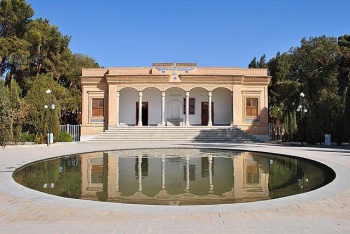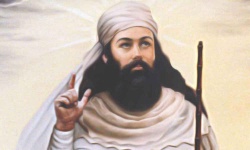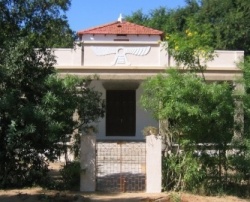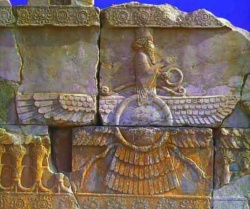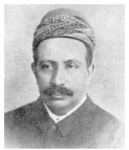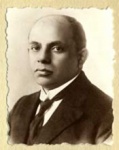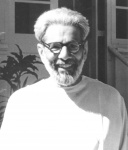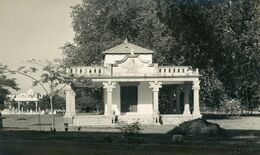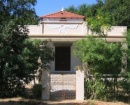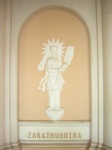Zoroastrianism: Difference between revisions
Linda Dorr (talk | contribs) |
|||
| (21 intermediate revisions by 2 users not shown) | |||
| Line 1: | Line 1: | ||
[[File:Zoroastrian Fire Temple in Yazd.JPG|right|350px|thumb|Zoroastrian fire temple in Yazd, Iran]] | |||
'''Zoroastrianism''' is one of the world's oldest religions that is still practiced today, and the oldest surviving monotheistic religion. It takes its name from the Iranian-speaking Prophet called by the Greeks Zoroaster (Ζωροάστηρ). His name in Avestan is Zarathushtra (or Zarthost in Modern Persian) meaning "Golden Shining Star." Another name for this religion is '''Mazdayasna,''' which combines "Mazda" (God's wisdom) with the word "yasna" (worship, devotion). Many scholars think that this is the original source of religious conceptions of heaven, hell, Satan, and Judgment Day, present in Judaism, Christianity and Islam. | '''Zoroastrianism''' is one of the world's oldest religions that is still practiced today, and the oldest surviving monotheistic religion. It takes its name from the Iranian-speaking Prophet called by the Greeks Zoroaster (Ζωροάστηρ). His name in Avestan is Zarathushtra (or Zarthost in Modern Persian) meaning "Golden Shining Star." Another name for this religion is '''Mazdayasna,''' which combines "Mazda" (God's wisdom) with the word "yasna" (worship, devotion). Many scholars think that this is the original source of religious conceptions of heaven, hell, Satan, and Judgment Day, present in Judaism, Christianity and Islam. | ||
== History == | == History == | ||
[[File:Zoroaster.jpg|250px|right]] | [[File:Zoroaster.jpg|250px|right|thumb|Zarathusthra]] | ||
The founder of Zoroastrianism is a mysterious prophetic figure known as Zarathushtra, born to father Paurushasp and mother Doghdo, who were highly commendable pure souls. He is regarded as a wise and pure human being, not as a manifestation of God. Scholars have struggled to determine the century in which he may have lived. The closest to a scholarly consensus is sometime in the late second millennium (2,000 to 1,000) BCE, somewhere in Central Asia (near modern-day Uzbekistan and Tajikistan). It is said that at his birth he had a smile on his face and that his aura spread light all over the town. His opponents somehow came to know that their nemesis is approaching and so they tried to kill the child several times. However, his life was saved through divine intervention. Zarathushtra grew up as a youth given to deep meditation and spent ten years in mountain retreat learning to solve many problems of life that baffled humanity. | The founder of Zoroastrianism is a mysterious prophetic figure known as Zarathushtra, born to father Paurushasp and mother Doghdo, who were highly commendable pure souls. He is regarded as a wise and pure human being, not as a manifestation of God. Scholars have struggled to determine the century in which he may have lived. The closest to a scholarly consensus is sometime in the late second millennium (2,000 to 1,000) BCE, somewhere in Central Asia (near modern-day Uzbekistan and Tajikistan). It is said that at his birth he had a smile on his face and that his aura spread light all over the town. His opponents somehow came to know that their nemesis is approaching and so they tried to kill the child several times. However, his life was saved through divine intervention. Zarathushtra grew up as a youth given to deep [[meditation]] and spent ten years in mountain retreat learning to solve many problems of life that baffled humanity. | ||
While there is very little historical information on the life of this prophet, the Greeks thought he flourished around 6,300 BCE; as noted above, modern historians believe this was closer to 1,000 BCE.<ref>https://www.youtube.com/watch?v=hl9QgeHdKYk</ref> | While there is very little historical information on the life of this prophet, the Greeks thought he flourished around 6,300 BCE; as noted above, modern historians believe this was closer to 1,000 BCE.<ref>https://www.youtube.com/watch?v=hl9QgeHdKYk</ref> | ||
| Line 10: | Line 11: | ||
All of that said, today’s Zoroastrians state that Zartathushtra, “prophet of the world’s oldest revealed religion, lived in remote antiquity, some time around the dawn of the Iranian bronze age, circa 1,800–1,100 BCE. His place of birth was … in Central Asia, possibly somewhere around the Aral Sea. In his thirtieth year, Zarathushtra received the revelation and started on his mission to bring His message to mankind.”<ref>Rivetna, Rohinton M: ''Zoroastrians (Zarathushtis): Followers of an Ancient Faith that is Relevant in the Modern World''. Burr Ridge, IL: Federation of Zoroastrian Associations of North America (FEZANA). 5th edition 2023. (Pamphlet from the Zorastrian booth at the 2023 Parliament of World Religions, Chicago, Illinois.)</ref> | All of that said, today’s Zoroastrians state that Zartathushtra, “prophet of the world’s oldest revealed religion, lived in remote antiquity, some time around the dawn of the Iranian bronze age, circa 1,800–1,100 BCE. His place of birth was … in Central Asia, possibly somewhere around the Aral Sea. In his thirtieth year, Zarathushtra received the revelation and started on his mission to bring His message to mankind.”<ref>Rivetna, Rohinton M: ''Zoroastrians (Zarathushtis): Followers of an Ancient Faith that is Relevant in the Modern World''. Burr Ridge, IL: Federation of Zoroastrian Associations of North America (FEZANA). 5th edition 2023. (Pamphlet from the Zorastrian booth at the 2023 Parliament of World Religions, Chicago, Illinois.)</ref> | ||
Zoroastrianism was the major religion in Iran and surrounding areas for a thousand years (559 BCE to 651 CE), with millions of followers.<ref>ibid.</ref> The priests, very learned astronomers, were known as Magi. (The three Wise Men in the story of the birth of Christ were Zoroastrians.)<ref>https://www.youtube.com/watch?v=hl9QgeHdKYk</ref> During the 7th century of the common era, Zoroastrianism began to decline due to the Muslim invasion of Iran (641 CE). Faced with persecution, many Zoroastrians converted to Islam, while some maintained their faith despite oppression. Still others migrated. In the 900s, when Iran had been renamed Persia, Zoroastrians who had voyaged to western India found sanctuary there. Their descendants, known as Parsis, are still practicing their faith in that country.<ref>Rivetna, ''Zoroastrians''</ref> | |||
=== Deity === | === Deity === | ||
| Line 16: | Line 19: | ||
Ahura Mazda unfolds the twin forces of nature namely, "Spenta Mainyu" (the Benevolent Spirit) and "Angra Mainyu" (the Destructive Spirit, embodied in "Ahriman"--the equivalent of Satan in the Judeo-Christian tradition). The main spiritual force coming from Ahura Mazda is "Asha," the cosmic order, which is the antithesis of "Druj" or chaos, falsehood and disorder, coming from Angra Mainyu. | Ahura Mazda unfolds the twin forces of nature namely, "Spenta Mainyu" (the Benevolent Spirit) and "Angra Mainyu" (the Destructive Spirit, embodied in "Ahriman"--the equivalent of Satan in the Judeo-Christian tradition). The main spiritual force coming from Ahura Mazda is "Asha," the cosmic order, which is the antithesis of "Druj" or chaos, falsehood and disorder, coming from Angra Mainyu. | ||
=== Zoroastrians Today === | |||
As of 2013, it was estimated that there were fewer than 200,000 Zorastrians in the world. The largest populations reside in the “homelands” of Iran (15,000 to 25,000) and India (61,000). In the last 60 years or so, many Zoroastrians have dispersed around the globe, generally serving their adopted countries well in terms of their participation in business and professional life. This includes the U.S. (14,500), Canada (6,500), Great Britain (5,500), Australia and New Zealand (3,800), the Persian Gulf (1,900), Pakistan (1,700), Europe (1,000), Singapore and Hong Kong (600), as well as other countries.<ref>ibid.</ref> | |||
== Scriptures == | |||
The collected written wisdom of Zoroastrianism is known as the '''Avesta''' (also known as the '''Zend-Avesta'''). Originally written in the ancient Avestan language, this body of work includes various texts. | |||
The ''Yasna'' contains fundamental devotional rites as well as the Gathas, divinely revealed poetry or hymns whose composer was Zarathushtra himself.<ref>ibid.</ref> Less significant rituals are covered in the ''Visperad''; and the ''Vendidad'' contains Zoroastrian law both civil<ref>https://www.britannica.com/topic/Avesta-Zoroastrian-scripture</ref> and spiritual (including a “priestly code of protection”).<ref>Rivetna, ''Zoroastrians''</ref> The ''Khordeh Avesta'' is a compilation of prayers for daily life, including the 21 devotional hymns of the Yasht and the invocations of the Niyayesh and the Nirang.<ref>ibid.</ref> | |||
== Basic Tenets == | == Basic Tenets == | ||
[[File:Zoroastrian Temple - Adyar.jpg|250px|thumb|Zoroastrian Temple at Adyar]] | [[File:Zoroastrian Temple - Adyar.jpg|250px|thumb|Zoroastrian Temple at Adyar]] | ||
The Zoroastrian ethic is one of personal accountability. Individuals are responsible for thinking "with a clear mind" and choosing "a life of intelligent reflection and active benevolence." They are taught to be industrious, honest, and charitable.<ref>ibid.</ref> | |||
Zoroastrians don't have regularly scheduled times for worship services. However, they do have temples in which Zoroastrian priests or "magi" conduct ritual prayers in the ancient Avestan language during special days of the year. Otherwise, members pray individually. Fire is the most sacred element to Zoroastrians and figures prominently in temple rituals like the Yasna. An eternal flame is kept alight in Zoroastrian temples 24 hours a day. | Zoroastrians don't have regularly scheduled times for worship services. However, they do have temples in which Zoroastrian priests or "magi" conduct ritual prayers in the ancient Avestan language during special days of the year. Otherwise, members pray individually. Fire is the most sacred element to Zoroastrians and figures prominently in temple rituals like the Yasna. An eternal flame is kept alight in Zoroastrian temples 24 hours a day. | ||
| Line 39: | Line 52: | ||
Zoroastrianism emphasizes action over belief, since it is the actions we take in life that determine our fate in the afterlife. | Zoroastrianism emphasizes action over belief, since it is the actions we take in life that determine our fate in the afterlife. | ||
== | == Zoroastrianism and Theosophical Teachings == | ||
< | |||
It bears repeating that the Zoroastrian ethic is one of personal responsibility: each individual is invited “to choose a life of intelligent reflection and active benevolence … to lead an industrious, honest and charitable life.” As noted above, this is achieved by striving for good thoughts, good words, and good deeds. That is, we need to think for ourselves to establish beliefs; to speak truthfully; and to choose good over evil actions. We also need to be accountable for our actions and accept the consequences. The Path of Asha or Divine Law “embodies Righteousness, Truth, Wisdom, Justice and Progress,” a tall order, but one that Zoroastrians strive to follow. While there is plenty of conflict as we struggle to live ethically, eventually “the ultimate triumph of good over evil is assured.” Despite individual choices, our human destiny is eventually to evolve into perfected beings in a state of bliss.<ref>ibid.</ref> | |||
Theosophy echoes these ideas. While there are many teachings, there is no rigid dogma regarding spiritual reality. We are encouraged to study theosophical writings for ourselves, meditate on these ideas, and come to our own conclusions. Service to our fellow humans is also a core teaching; the only real “sin” in Theosophy is selfishness. Since Karma is a given, a Law of Nature (the Law of Cause and Effect), it behooves us to act ethically in everything we do. And while humanity’s ultimate destiny is to evolve from our current separateness into a Unity, we have the free will to choose whether we will work to further that aim or to serve our own egocentric ends. Reincarnation is another core teaching. In each new life we have a new personality; it is our Higher Self that absorbs the karmic lessons from each lifetime. We keep coming back until we get it right -- that is, until we have lived a life free of newly generated Karma. At that point we may choose to ascend to higher realms, or we may become what Buddhists call a Bodhisattva, one who returns to the earthly realm to assist the rest of humanity in our continuing spiritual evolution. | |||
== Zoroastrians and the Theosophical Society == | |||
=== Early history === | |||
Zoroastrians of the Parsi community were heavily engaged with the [[Founders|Theosophical Society Founders]], [[Henry Steel Olcott]] and [[Helena Petrovna Blavatsky]], even before the two debarked at Bombay for he first time in 1879. Colonel Olcott wrote of his early contacts in his autobiography, [[Old Diary Leaves (book)|''Old Diary Leaves'']]. | |||
<blockquote> | |||
It has been remarked already that the Bombay Parsis were friendly from the beginning, calling upon us with their families in numbers, asking us to their homes, dining with us, and pressing me to preside and distribute prizes at an anniversary of a Parsi girls’ school. While | |||
still in America, I had made friendly overtures to Mr. K. M. Shroff, who had just completed a lecturing tour in my country and returned home. He accepted membership and on all occasions after our arrival at Bombay, rendered us loyal help.<ref>H. S. Olcott, "Old Diary Leaves Oriental Series - Chapter III" The Theosophist 16 no. 3 (December 1894): 138.</ref> | |||
</blockquote> | |||
<blockquote> | |||
Influential Parsi gentlemen ... called on us, among them Mr. K. It. Cama, the Orientalist, and his famous father-in-law, the late Mr. Manockjee Cursetjee, the reforming pioneer, whose charming daughters were with him, received at several European Courts and universally admired.<ref>H. S. Olcott, "Old Diary Leaves Oriental Series - Chapter III" The Theosophist 16 no. 3 (December 1894): 138.</ref> | |||
</blockquote> | |||
The small Zoroastrian community was generally wealthy, literate, and open to interfaith cooperation. Parsis and Hindus worked together to form the Bombay Branch of the Theosophical Society. Representatives of both faiths, including Parsi [[Sorabji J. Padshah]], joined a delegation in a good-will visit to the Buddhists of Ceylon in May, 1880. | |||
Parsis made their public meeting halls available for Theosophical lectures, as when the President-Founder Olcott inaugurated his public Theosophical activities in India with an address delivered at the Framji Cawasji Hall early in 1879.<ref>K. J. B. Wadia.''[https://archive.org/details/WadiaFiftyYearsOfTheosophyInBombay/page/n17 Fifty years of theosophy in Bombay: being a history of the Blavatsky Lodge, Theosophical Society, Bombay,1880-1930]'' (Adyar, Madras, India: Theosophical Publishing House, 1931), 6.</ref> The community was very generous furnishing the residence of the Founders, and for many decades provided funding for Theosophical causes. | |||
=== Prominent Zoroastrian Theosophists === | |||
These practitioners of Zoroastrianism were Theosophists and significant to the [[Theosophical Movement]]. Two culturally distinct groups of Zoroastrians exist in India: '''Parsis or Parsees''', who descended from Persians who emigrated to India in the 8th and 10th centuries CE; and '''Iranis''', who made a similar migration many centuries later. Theosophists were generally Parsis. | |||
<gallery widths="130px" heights="150px" perrow="5"> | |||
File:N._D._Khandalavala.jpg|<center>|N. D. Khandalavala</center> | |||
File:B._J._Padshah.jpg|<center>Burjorji J. Padshah</center> | |||
File:Col_Ghadiali.jpg|<center>Dinshah P. Ghadiali</center> | |||
File:B_P_Wadia_1.jpg|<center>B. P. Wadia</center> | |||
File:S J Padshah with HPB, 1880.jpg|<center>Sorabji J. Padshah</center> | |||
</gallery> | |||
'''[[N. D. Khandalavala]]''' (Khān Bahādur Navroji Dorabji Khandalavala) was a provincial judge who greatly assisted the [[Founders]] after becoming a member in 1879. He corresponded with [[H. P. Blavatsky|Madame Blavatsky]], who disclosed to him important information about the Mahatmas and other matters. | |||
'''[[K. M. Shroff]]''' was a highly educated Parsi member in Bombay. In 1874 he lectured in the United States, and Shroff joined the [[Theosophical Society]] by corresponding with the [[Founders]] before they left New York, making him one of the earliest Indian members. He was vice president of the Bombay Branch from 1882 to 1885, a member of the TS General Council, and a major speaker at the 1882 convention. [[Henry Steel Olcott|Col. Olcott]] referred to him as “the all-accomplishing Mr. K. M. Shroff.”<ref>H. S. Olcott, "Charities" ''Lucifer'' 3 no. 18 (February, 1889): 503.</ref> Certainly, he was persuasive and energetic; and he helped to establish the Homeopathic Charitable Dispensary and Bombay Veterinary College and Hospital, working with [[Tukaram Tatya]]. Shroff testified in support of HPB in the [[The Vega Incident|Vega incident]]. In 1883 he become editor of the ''Jam-e-Jamshed'' daily newspaper published in Gujarati and English. | |||
'''[[Khurshedji N. Seervai|Khurshedji Nusserwanji Seervai]]''' (?–1897) was a highly educated and devoted Parsi Theosophist, and an eloquent speaker. Serving as Joint Recording Secretary of the Theosophical Society in 1880, he signed up about 200 two hundred subscribers to ''The Theosophist'' when it was a new publication. He helped organize the Bombay Branch, and was one of its founding officers. He worked as a tax collector, but found time to author ''Zoroastrianism and Theosophy'' and several other texts. After the [[Hodgson Report]] was published, he resigned from membership in the Society. | |||
'''[[Sorabji J. Padshah]]''' (1856-1927) was another Parsi who joined the Society in 1880. He traveled with the Founders on their first trip to Ceylon, and served as Assistant Recording Secretary and on the General Council. In 1881 he received [[Mahatma Letter to Padshah - LMW 2 No. 77|an encouraging letter from Master K.H.]], but after a few years he lost interest in Theosophy. | |||
His younger brother '''[[Burjorji J. Padshah]]''' (1864-1941) was a mathematics professor trained at Cambridge. He exerted great influence on the development of India’s largest conglomerate, the Tata Group, and on establishment of the Indian Institute of Science. He practiced Theosophical principles his whole life, abstaining from meat, leather, alcohol, and tobacco and advocating for animal welfare. | |||
'''[[B. P. Wadia]]''' (1881-1958) was an important figure in the Theosophical Movement in the twentieth century. After joining the [[Theosophical Society (Adyar)|Theosophical Society]] in Bombay in 1904, he worked in the publishing house of the Society. He was interned by the British in 1917 with [[Annie Besant]] and [[George S. Arundale]]. In 1922, he resigned very publicly from the Adyar-based Society to embrace the [[United Lodge of Theosophists]] and its strict focus on the original writings of [[H. P. Blavatsky]]. He was a prolific and influential writer and editor. | |||
'''[[Dinshah Ghadiali|Dinshah P. Ghadiali]]''' (1873-1966) was born in India but became a naturalized American citizen. His interests in medicine and electrical engineering led to patenting the Spectro-Chrome device for light therapy. He was a member of the [[Theosophical Society]] from 1891 to 1966, and published at least 16 books. | |||
[[File:Adyar Zoroastrian Temple.jpg|right|260px|thumb|Zoroastrian Temple, Adyar]] | |||
=== Adyar headquarters === | |||
While the number of Zoroastrians in India has decreased sharply since the early days of the Theosophical Society, | |||
this religious group is still honored at the Society's international headquarters. The residence of international [[Theosophical Society (Adyar)|Theosophical Society]] president [[Radha Burnier]] in the headquarters estate was called '''Parsi Quarters'''. That [[Adyar (campus)|campus]] also has a '''Zoroastrian Temple'''. '''Zarathusthra''', the founder of Zoroastrianism, is carved in relief on a wall of the Great Hall of the Headquarters building. Zoroastrians are regularly invited to participate in offering '''prayers''' at the openings of Theosophical Society conventions in India, the United States, and elsewhere. | |||
<gallery widths="130px" heights="150px" perrow="5"> | |||
File:Zoroastrian_Temple_-_Adyar.jpg|<center>Zoroastrian Temple</center> | |||
File:Parsi House.JPG|<center>Parsi Quarters</center> | |||
File:Zarathustra.jpg|<center>Zarathusthra relief</center> | |||
</gallery> | |||
== Additional resources == | |||
=== Articles === | |||
* [https://www.theosophy.world/encyclopedia/zoroastrianism Zoroastrianism] in Theosophy World | |||
* [https://www.theosophy.world/encyclopedia/ahriman Ahriman] in Theosophy World | |||
* [https://www.theosophy.world/encyclopedia/ahura-mazda Ahura Mazda] in Theosophy World | |||
* [https://www.theosophy.world/encyclopedia/amesha-spentas Amesha Spentas] in Theosophy World | |||
* [http://hpb.narod.ru/Zoroastrianism.htm# Zoroastrianism] by Annie Besant | |||
* [https://www.theosophical.org/publications/quest-magazine/zoroastrianism-history-beliefs-and-practices Zoroastrianism: History, Beliefs, and Practices] by Dinshaw and Hutoxy Contractor | |||
* [http://www.blavatsky.net/theosophy/judge/articles/karma-in-the-desatir.htm# Karma in the Desatir] by William Q. Judge | |||
* [https://www.theosophical.org/publications/quest-magazine/dark-and-light-in-yazd-central-iran Dark and Light in Yazd Central Iran] by Barbara Cunliffe Singleton | |||
== | === Books === | ||
* [https://archive.org/stream/zoroastrianismin00biliuoft/zoroastrianismin00biliuoft_djvu.txt Zoroastrianism in the Light of Theosophy] by Nasarvanji Framji Bilimoria. Bombay: "Blavatsky Lodge" Theosophical Society, 1898. | |||
*[ | |||
=== Videos === | === Videos === | ||
*[https://youtu.be/8mabPHq7EAI# Zoroastrianism and The Sacred Fire] by Aban Patel | |||
== References == | |||
<references /> | |||
[[Category:Religions]] | [[Category:Religions]] | ||
Latest revision as of 13:57, 16 September 2024
Zoroastrianism is one of the world's oldest religions that is still practiced today, and the oldest surviving monotheistic religion. It takes its name from the Iranian-speaking Prophet called by the Greeks Zoroaster (Ζωροάστηρ). His name in Avestan is Zarathushtra (or Zarthost in Modern Persian) meaning "Golden Shining Star." Another name for this religion is Mazdayasna, which combines "Mazda" (God's wisdom) with the word "yasna" (worship, devotion). Many scholars think that this is the original source of religious conceptions of heaven, hell, Satan, and Judgment Day, present in Judaism, Christianity and Islam.
History
The founder of Zoroastrianism is a mysterious prophetic figure known as Zarathushtra, born to father Paurushasp and mother Doghdo, who were highly commendable pure souls. He is regarded as a wise and pure human being, not as a manifestation of God. Scholars have struggled to determine the century in which he may have lived. The closest to a scholarly consensus is sometime in the late second millennium (2,000 to 1,000) BCE, somewhere in Central Asia (near modern-day Uzbekistan and Tajikistan). It is said that at his birth he had a smile on his face and that his aura spread light all over the town. His opponents somehow came to know that their nemesis is approaching and so they tried to kill the child several times. However, his life was saved through divine intervention. Zarathushtra grew up as a youth given to deep meditation and spent ten years in mountain retreat learning to solve many problems of life that baffled humanity.
While there is very little historical information on the life of this prophet, the Greeks thought he flourished around 6,300 BCE; as noted above, modern historians believe this was closer to 1,000 BCE.[1]
There is a suggestion that there was a line of prophets named Zoroaster or Zarathushtra.[2] [3] [4] Annie Besant, the second international president of the Theosophical Society, proposed that this may have been the same spirit — what theosophy calls a Monad — reincarnating: “… when we are speaking of a line of prophets, it by no means follows that each prophet is a separate individual, for the same soul often reincarnates time after time in the same office … always superintending the spiritual evolution of mankind …. [T]he Zoroaster spoken of by Aristotle 9,600 years before what we call the time of Christ (dated of course by him from Plato, not from Christ) was seventh of this name from the original Zoroaster …. Still later there was another Zoroaster, about the year 4000 before Christ, who again revived the ancient teaching.”[5]
All of that said, today’s Zoroastrians state that Zartathushtra, “prophet of the world’s oldest revealed religion, lived in remote antiquity, some time around the dawn of the Iranian bronze age, circa 1,800–1,100 BCE. His place of birth was … in Central Asia, possibly somewhere around the Aral Sea. In his thirtieth year, Zarathushtra received the revelation and started on his mission to bring His message to mankind.”[6]
Zoroastrianism was the major religion in Iran and surrounding areas for a thousand years (559 BCE to 651 CE), with millions of followers.[7] The priests, very learned astronomers, were known as Magi. (The three Wise Men in the story of the birth of Christ were Zoroastrians.)[8] During the 7th century of the common era, Zoroastrianism began to decline due to the Muslim invasion of Iran (641 CE). Faced with persecution, many Zoroastrians converted to Islam, while some maintained their faith despite oppression. Still others migrated. In the 900s, when Iran had been renamed Persia, Zoroastrians who had voyaged to western India found sanctuary there. Their descendants, known as Parsis, are still practicing their faith in that country.[9]
Deity
Zoroastrianism was the first ancient monotheistic religion. Zarathushtra broke with the existing polytheistic religions of Central Asia and established the single divine authority of Ahura Mazda, or the "Wise Lord" (Avestan: Ahura = "Lord" and Mazda = "Wisdom"). Ahura Mazda is described as a universal, transcendent, unknowable, and all-good creator. He is considered to be omniscient but not omnipotent. He has three Aspects, which are "Ahu," the Creator; "Vohu Mana" or Good mind, the Preserver; and Asha Vahishta, the Reconstructor. He is assisted by six emanations called Amesha-spentas, the Holy Immortals (archangels) representing His attributes to rule over kingdoms of nature and animals. These Ameshaspentas were helped by 33 "angels" known as Yazatas (meaning "worthy of worship") in their work.
Ahura Mazda unfolds the twin forces of nature namely, "Spenta Mainyu" (the Benevolent Spirit) and "Angra Mainyu" (the Destructive Spirit, embodied in "Ahriman"--the equivalent of Satan in the Judeo-Christian tradition). The main spiritual force coming from Ahura Mazda is "Asha," the cosmic order, which is the antithesis of "Druj" or chaos, falsehood and disorder, coming from Angra Mainyu.
Zoroastrians Today
As of 2013, it was estimated that there were fewer than 200,000 Zorastrians in the world. The largest populations reside in the “homelands” of Iran (15,000 to 25,000) and India (61,000). In the last 60 years or so, many Zoroastrians have dispersed around the globe, generally serving their adopted countries well in terms of their participation in business and professional life. This includes the U.S. (14,500), Canada (6,500), Great Britain (5,500), Australia and New Zealand (3,800), the Persian Gulf (1,900), Pakistan (1,700), Europe (1,000), Singapore and Hong Kong (600), as well as other countries.[10]
Scriptures
The collected written wisdom of Zoroastrianism is known as the Avesta (also known as the Zend-Avesta). Originally written in the ancient Avestan language, this body of work includes various texts.
The Yasna contains fundamental devotional rites as well as the Gathas, divinely revealed poetry or hymns whose composer was Zarathushtra himself.[11] Less significant rituals are covered in the Visperad; and the Vendidad contains Zoroastrian law both civil[12] and spiritual (including a “priestly code of protection”).[13] The Khordeh Avesta is a compilation of prayers for daily life, including the 21 devotional hymns of the Yasht and the invocations of the Niyayesh and the Nirang.[14]
Basic Tenets
The Zoroastrian ethic is one of personal accountability. Individuals are responsible for thinking "with a clear mind" and choosing "a life of intelligent reflection and active benevolence." They are taught to be industrious, honest, and charitable.[15]
Zoroastrians don't have regularly scheduled times for worship services. However, they do have temples in which Zoroastrian priests or "magi" conduct ritual prayers in the ancient Avestan language during special days of the year. Otherwise, members pray individually. Fire is the most sacred element to Zoroastrians and figures prominently in temple rituals like the Yasna. An eternal flame is kept alight in Zoroastrian temples 24 hours a day.
The Sun is specially mentioned the most beautiful body of God which gives light on earth. Fire ("Atash," the most adorable son of Ahura Mazda) became the emblem of the most Bountiful Creator, reminding devotees of God's glory that is light, heat, energy, vitality and virility. The Mazdayasni people founded temples and tended the fire there. These temples are known as Fire Temples or Atash Behram. All Zoroastrians bow to the sacred fire which burns in the Fire Temples or in their house.
The consecrated fires in the Fire Temples not only give out light and heat from the altar, but within the shrine is the aura (Khureh) of the Almighty, kept glowing through the presence of an invisible Guardian Angel. This occult presence is thought to bless those who offer their devotion.
Zoroastrianism was an early (some claim the first) religion emphasizing ecology, believing in preserving and respecting all creations of nature, being careful not to exploit it as this would seriously disturb ecological balance to the detriment of humankind. It preaches that Ashoi (Purity) must be observed--not only of body and mind, but also of environment and all elements of nature, like fire, water, air, earth, space, plant life and animal life.
For this reason, Zoroastrians traditionally buried their dead in special towers (later called "Towers of Silence") where the corpses would be left to be eaten by birds of prey, thus not polluting the air, earth, fire or water. The bones would be bleached by the sun and then placed in a pit. Currently this is only practiced in India, as in most parts of the world this would be illegal or considered inappropriate. Modern Zoroastrians may bury their dead in graves protected by concrete or stone.
The most visible symbol of Zoroastrianism is the Farohar or Faravahar, what looks like a large winged eagle with the body and head of a bearded man. This image is famously carved into the ruins at Persepolis, the ancient capital of the Zoroastrian Achaemenid Empire in Iran, and it now graces Zoroastrian temples and grave sites.
Traditionally, Zoroastrians have not converted people to their faith. However, recently, they have begun to accept those who decide to become Zoroastrians through their own choice.
Moral Message
To Zoroastrians, all of reality is shaped by the dueling forces of light and dark, and every human being is free to choose their own path. The purpose of life, then, is to actively choose the good in thought, word and deed. Ahura Mazda revealed to Zoroaster the divine message of purity, uprightness and truth. His theology includes foremost the importance of following the Threefold Path of Asha: Humata Hukhat Huvarashta, i.e., "Good Thoughts, Good Words and Good Deeds." Since humans are endowed with a thinking mind, they must choose freely whether to follow the right path or not. There is also a heavy emphasis on spreading happiness, mostly through charity, and respecting the spiritual equality and duty of the genders.
Zoroastrianism emphasizes action over belief, since it is the actions we take in life that determine our fate in the afterlife.
Zoroastrianism and Theosophical Teachings
It bears repeating that the Zoroastrian ethic is one of personal responsibility: each individual is invited “to choose a life of intelligent reflection and active benevolence … to lead an industrious, honest and charitable life.” As noted above, this is achieved by striving for good thoughts, good words, and good deeds. That is, we need to think for ourselves to establish beliefs; to speak truthfully; and to choose good over evil actions. We also need to be accountable for our actions and accept the consequences. The Path of Asha or Divine Law “embodies Righteousness, Truth, Wisdom, Justice and Progress,” a tall order, but one that Zoroastrians strive to follow. While there is plenty of conflict as we struggle to live ethically, eventually “the ultimate triumph of good over evil is assured.” Despite individual choices, our human destiny is eventually to evolve into perfected beings in a state of bliss.[16]
Theosophy echoes these ideas. While there are many teachings, there is no rigid dogma regarding spiritual reality. We are encouraged to study theosophical writings for ourselves, meditate on these ideas, and come to our own conclusions. Service to our fellow humans is also a core teaching; the only real “sin” in Theosophy is selfishness. Since Karma is a given, a Law of Nature (the Law of Cause and Effect), it behooves us to act ethically in everything we do. And while humanity’s ultimate destiny is to evolve from our current separateness into a Unity, we have the free will to choose whether we will work to further that aim or to serve our own egocentric ends. Reincarnation is another core teaching. In each new life we have a new personality; it is our Higher Self that absorbs the karmic lessons from each lifetime. We keep coming back until we get it right -- that is, until we have lived a life free of newly generated Karma. At that point we may choose to ascend to higher realms, or we may become what Buddhists call a Bodhisattva, one who returns to the earthly realm to assist the rest of humanity in our continuing spiritual evolution.
Zoroastrians and the Theosophical Society
Early history
Zoroastrians of the Parsi community were heavily engaged with the Theosophical Society Founders, Henry Steel Olcott and Helena Petrovna Blavatsky, even before the two debarked at Bombay for he first time in 1879. Colonel Olcott wrote of his early contacts in his autobiography, Old Diary Leaves.
It has been remarked already that the Bombay Parsis were friendly from the beginning, calling upon us with their families in numbers, asking us to their homes, dining with us, and pressing me to preside and distribute prizes at an anniversary of a Parsi girls’ school. While still in America, I had made friendly overtures to Mr. K. M. Shroff, who had just completed a lecturing tour in my country and returned home. He accepted membership and on all occasions after our arrival at Bombay, rendered us loyal help.[17]
Influential Parsi gentlemen ... called on us, among them Mr. K. It. Cama, the Orientalist, and his famous father-in-law, the late Mr. Manockjee Cursetjee, the reforming pioneer, whose charming daughters were with him, received at several European Courts and universally admired.[18]
The small Zoroastrian community was generally wealthy, literate, and open to interfaith cooperation. Parsis and Hindus worked together to form the Bombay Branch of the Theosophical Society. Representatives of both faiths, including Parsi Sorabji J. Padshah, joined a delegation in a good-will visit to the Buddhists of Ceylon in May, 1880.
Parsis made their public meeting halls available for Theosophical lectures, as when the President-Founder Olcott inaugurated his public Theosophical activities in India with an address delivered at the Framji Cawasji Hall early in 1879.[19] The community was very generous furnishing the residence of the Founders, and for many decades provided funding for Theosophical causes.
Prominent Zoroastrian Theosophists
These practitioners of Zoroastrianism were Theosophists and significant to the Theosophical Movement. Two culturally distinct groups of Zoroastrians exist in India: Parsis or Parsees, who descended from Persians who emigrated to India in the 8th and 10th centuries CE; and Iranis, who made a similar migration many centuries later. Theosophists were generally Parsis.
N. D. Khandalavala (Khān Bahādur Navroji Dorabji Khandalavala) was a provincial judge who greatly assisted the Founders after becoming a member in 1879. He corresponded with Madame Blavatsky, who disclosed to him important information about the Mahatmas and other matters.
K. M. Shroff was a highly educated Parsi member in Bombay. In 1874 he lectured in the United States, and Shroff joined the Theosophical Society by corresponding with the Founders before they left New York, making him one of the earliest Indian members. He was vice president of the Bombay Branch from 1882 to 1885, a member of the TS General Council, and a major speaker at the 1882 convention. Col. Olcott referred to him as “the all-accomplishing Mr. K. M. Shroff.”[20] Certainly, he was persuasive and energetic; and he helped to establish the Homeopathic Charitable Dispensary and Bombay Veterinary College and Hospital, working with Tukaram Tatya. Shroff testified in support of HPB in the Vega incident. In 1883 he become editor of the Jam-e-Jamshed daily newspaper published in Gujarati and English.
Khurshedji Nusserwanji Seervai (?–1897) was a highly educated and devoted Parsi Theosophist, and an eloquent speaker. Serving as Joint Recording Secretary of the Theosophical Society in 1880, he signed up about 200 two hundred subscribers to The Theosophist when it was a new publication. He helped organize the Bombay Branch, and was one of its founding officers. He worked as a tax collector, but found time to author Zoroastrianism and Theosophy and several other texts. After the Hodgson Report was published, he resigned from membership in the Society.
Sorabji J. Padshah (1856-1927) was another Parsi who joined the Society in 1880. He traveled with the Founders on their first trip to Ceylon, and served as Assistant Recording Secretary and on the General Council. In 1881 he received an encouraging letter from Master K.H., but after a few years he lost interest in Theosophy. His younger brother Burjorji J. Padshah (1864-1941) was a mathematics professor trained at Cambridge. He exerted great influence on the development of India’s largest conglomerate, the Tata Group, and on establishment of the Indian Institute of Science. He practiced Theosophical principles his whole life, abstaining from meat, leather, alcohol, and tobacco and advocating for animal welfare.
B. P. Wadia (1881-1958) was an important figure in the Theosophical Movement in the twentieth century. After joining the Theosophical Society in Bombay in 1904, he worked in the publishing house of the Society. He was interned by the British in 1917 with Annie Besant and George S. Arundale. In 1922, he resigned very publicly from the Adyar-based Society to embrace the United Lodge of Theosophists and its strict focus on the original writings of H. P. Blavatsky. He was a prolific and influential writer and editor.
Dinshah P. Ghadiali (1873-1966) was born in India but became a naturalized American citizen. His interests in medicine and electrical engineering led to patenting the Spectro-Chrome device for light therapy. He was a member of the Theosophical Society from 1891 to 1966, and published at least 16 books.
Adyar headquarters
While the number of Zoroastrians in India has decreased sharply since the early days of the Theosophical Society, this religious group is still honored at the Society's international headquarters. The residence of international Theosophical Society president Radha Burnier in the headquarters estate was called Parsi Quarters. That campus also has a Zoroastrian Temple. Zarathusthra, the founder of Zoroastrianism, is carved in relief on a wall of the Great Hall of the Headquarters building. Zoroastrians are regularly invited to participate in offering prayers at the openings of Theosophical Society conventions in India, the United States, and elsewhere.
Additional resources
Articles
- Zoroastrianism in Theosophy World
- Ahriman in Theosophy World
- Ahura Mazda in Theosophy World
- Amesha Spentas in Theosophy World
- Zoroastrianism by Annie Besant
- Zoroastrianism: History, Beliefs, and Practices by Dinshaw and Hutoxy Contractor
- Karma in the Desatir by William Q. Judge
- Dark and Light in Yazd Central Iran by Barbara Cunliffe Singleton
Books
- Zoroastrianism in the Light of Theosophy by Nasarvanji Framji Bilimoria. Bombay: "Blavatsky Lodge" Theosophical Society, 1898.
Videos
- Zoroastrianism and The Sacred Fire by Aban Patel
References
- ↑ https://www.youtube.com/watch?v=hl9QgeHdKYk
- ↑ https://www.ancient-origins.net/history-famous-people/who-was-zoroaster-and-how-did-he-gain-religious-followers-007684: “Plutarch, for example, wrote that Zoroaster lived 5000 years before the Trojan War” [which is dated to around the 12th or 13th century BCE]
- ↑ https://www.britannica.com/topic/Manichaeism: “Mani viewed himself as the final successor in a long line of prophets, beginning with Adam and including Buddha, Zoroaster, and Jesus.”
- ↑ Widengren, Geo (1961). Mani and Manichaeism. London: Weidenfeld and Nicolson. p. 76. [cited at https://en.wikipedia.org/wiki/Zarathustra_in_Manichaeism]: “Manichaeism considers Zarathustra to be a figure in a line of prophets of which Mani (216–276) was the culmination.”
- ↑ Besant, Annie: Seven Great Religions. Adyar, Madras, India: The Theosophical Publishing House, 1966, pp. 49-50 (First Edition 1897)
- ↑ Rivetna, Rohinton M: Zoroastrians (Zarathushtis): Followers of an Ancient Faith that is Relevant in the Modern World. Burr Ridge, IL: Federation of Zoroastrian Associations of North America (FEZANA). 5th edition 2023. (Pamphlet from the Zorastrian booth at the 2023 Parliament of World Religions, Chicago, Illinois.)
- ↑ ibid.
- ↑ https://www.youtube.com/watch?v=hl9QgeHdKYk
- ↑ Rivetna, Zoroastrians
- ↑ ibid.
- ↑ ibid.
- ↑ https://www.britannica.com/topic/Avesta-Zoroastrian-scripture
- ↑ Rivetna, Zoroastrians
- ↑ ibid.
- ↑ ibid.
- ↑ ibid.
- ↑ H. S. Olcott, "Old Diary Leaves Oriental Series - Chapter III" The Theosophist 16 no. 3 (December 1894): 138.
- ↑ H. S. Olcott, "Old Diary Leaves Oriental Series - Chapter III" The Theosophist 16 no. 3 (December 1894): 138.
- ↑ K. J. B. Wadia.Fifty years of theosophy in Bombay: being a history of the Blavatsky Lodge, Theosophical Society, Bombay,1880-1930 (Adyar, Madras, India: Theosophical Publishing House, 1931), 6.
- ↑ H. S. Olcott, "Charities" Lucifer 3 no. 18 (February, 1889): 503.
